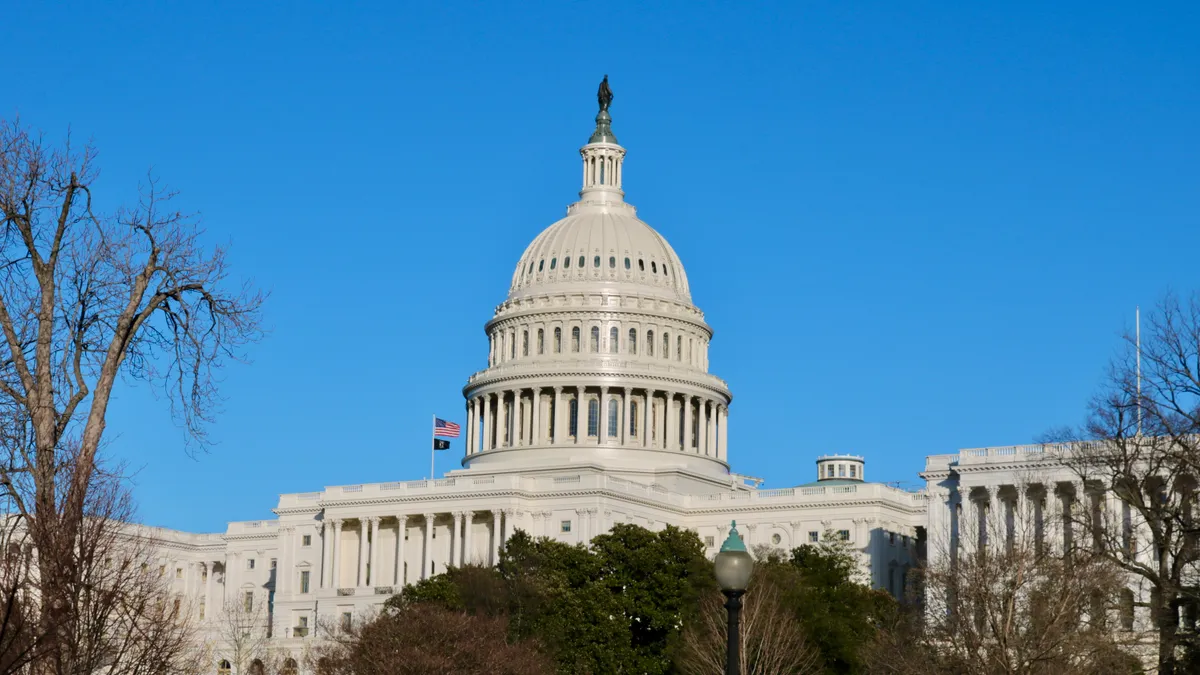UPDATE: Sept. 15, 2021: The House Energy and Commerce Committee approved the $150 billion Clean Electricity Performance Program Tuesday. It also approved billions of dollars in other spending for electric vehicles, transmission, and other energy and climate priorities that are part of the committee's section of the $3.5 trillion budget reconciliation package.
The Clean Electricity Performance Program's future is uncertain as Senate Energy and Natural Resources Committee Chair Joe Manchin, a Democrat from West Virginia, has voiced opposition to it.
Dive Brief:
- The House Energy and Commerce Committee met Monday to mark up Democrats’ plan for a Clean Electricity Performance Program, along with other energy and environmental provisions in the $3.5 trillion budget reconciliation package.
- The committee’s $486.5 billion portion of the bill includes rebates for energy efficiency retrofits, new electric-vehicle infrastructure and funding for clean energy in disadvantaged communities. The bill would also spend $9 billion on upgrading the electricity grid.
- Specifically, the reconcilliation package includes $3 billion for EV supply equipment and public chargers, with $1 billion dedicated to serving low-income areas. The bill would also appropriate $4 billion to Department of Energy's plug-in electric drive program, $6 billion in grants for near-term transportation sector electrification and $5 billion for new grants and rebates for heavy-duty EVs.
Dive Insight:
Democrats have pledged to use the reconciliation bill to advance aggressive climate change legislation.
"Investments proposed by House Energy & Commerce will help transform markets & avoid the worst impacts of climate change, while benefiting historically marginalized communities most. This will create millions of good jobs, save lives, & increase prosperity," said Rocky Mountain Institute CEO Jules Kortenhorst in a statement.
The Senate Energy and Natural Resources Committee — which would pass the Senate’s Clean Electricity Performance Program and energy language — and the Environment and Public Works Committee — which handles clean vehicles and energy-efficient buildings — have not released their draft text. Senate Majority Leader Chuck Schumer, a Democrat from New York, has said he plans to release draft text by the end of this week, despite calls from Joe Manchin, a Democrat from West Virginia, to slow down the process.
The Clean Electricity Performance Program is a modified version of a clean energy standard that works under the rules of a budget reconciliation bill, which requires that policy must be related to taxes, spending or debt. The program, as detailed in the committee text, would run from 2023 through 2030.
Text of the plan, released last week, detailed a $150 billion program that would require electric providers to increase the amount of clean energy distributed to customers by 4% year over year. Providers that meet the goal would get grants from the DOE, while those falling short would owe money.
The program is the centerpiece of Democrats’ plan to achieve 80% clean electricity by 2030, in line with a clean energy standard plan backed by the Biden administration, which has also called for 100% clean power by 2035. It has been praised as an effective carrot-and-stick approach to push utilities, electricity retailers and municipal power providers to purchase more renewable energy.
Some experts have raised concerns that the structure of the program could allow for manipulation that limits clean energy deployment. On Twitter, Tufts University associate professor of economics Steve Cicala warned that the year-over-year thresholds could allow for "cycling," where utilities do nothing and purchase clean certificates in subsequent years to offset fines.
1) Cycling: the regulatory threshold for year Y is based on year Y-1 alone, and penalties & rewards are asymmetric. This means a utility can: do nothing in year 1 and pay a fine of $40/MWh (which they can delay payment on) on 2.5% of their load.
— Steve Cicala (@SteveCicala) September 10, 2021
Among the other provisions in the reconcilliation bill are:
- $9 billion for rebates for whole-house energy efficiency retrofits, with $500 million in training grants for contractors. Another $9 billion would go to rebates for electrification projects for homeowners and multifamily buildings.
- $3.2 billion for resiliency, efficiency and grid integration improvements at public and non-profit buildings.
- $9 billion total for grid improvements, including $8 billion to construct new long-distance transmission lines and upgrading interties between existing interconnections.
- $17.5 billion for DOE efforts to procure clean electricity, low-carbon materials and upgrades for federal buildings. Another $5 billion would go to the Energy Efficiency Conservation Block Grant program and $2.5 billion would support expansion of solar power in low-income communities













